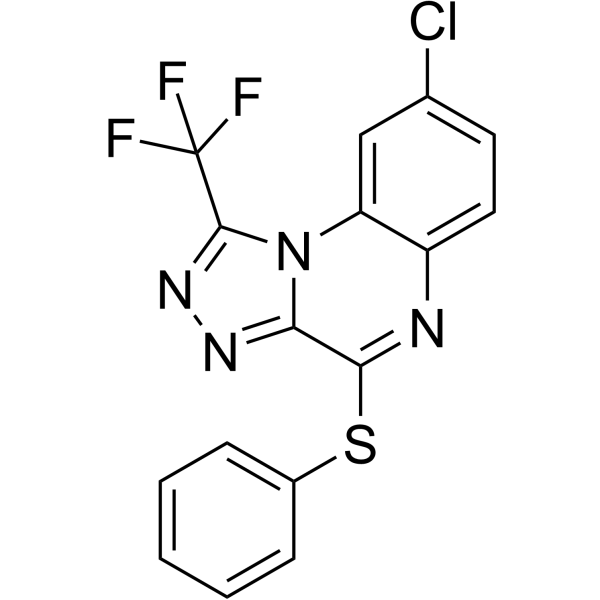产品
编 号:F312205
分子式:C16H8ClF3N4S
分子量:380.77
分子式:C16H8ClF3N4S
分子量:380.77
产品类型
规格
价格
是否有货
10mM*1mL in DMSO
询价
询价
1mg
询价
询价
5mg
询价
询价
10mg
询价
询价
25mg
询价
询价
50mg
询价
询价
100mg
询价
询价
结构图

CAS No: 303997-35-5
产品详情
生物活性:
R-7050 (TNF-α Antagonist III) is a tumor necrosis factor receptor (TNFR) antagonist with greater selectivity toward TNFα.
体内研究:
R-7050 (TNF-α Antagonist III) (6 mg/kg) reduces Evans blue extravasation to 28.7±5.9 μg and 30.3±1.9 μg Evans blue/g brain tissue when administered at 0.5 h or 2 h post-ICH, respectively (p<0.05 and p<0.01 vs ICH, respectively; not significantly different from sham). Brain water content, a measure of brain edema, increases from 75.6±0.3% in sham-operated mice to 81.5±0.5% at 24h post-ICH (p<0.05 vs. sham). 6, 12, or 18 mg/kg R-7050 reduces brain water content to 78.5±0.3%, 78.3±0.3%, or 79.3±0.5%, respectively (all treatments p<0.05 vs. ICH; treatments not significantly different from each other). Notably, mice treated with 18 mg/kg exhibit a reduction in general activity/locomotion. As is observed with Evans blue extravasation, R-7050 (6 mg/kg) significantly reduces brain water content after ICH. Administration of R-7050 at 0.5h or 2h post-ICH attenuates brain water content to levels observed in sham-operated mice (p<0.05 vs ICH, not significantly different from sham).
体外研究:
R-7050 (TNF-α Antagonist III) is a potent and fully reversible hit with greater selectivity toward TNFα. In TNFα-inducedintercellular adhesion molecule 1 (ICAM-1)expression, R-7050 inhibition potency (EC50=0.63 μM) is 2- to 3-fold greater than EC50 for IL-1β-induced ICAM-1 expression (EC50=1.45 2 μM). R-7050 inhibits phosphorylation of both the JNK pathway (MKK4, JNKs, and ATF2) and p38 pathway (MKK3/6, p38, and MAPKAP2). R-7050 is a cell-permeable triazoloquinoxaline compound that selectively inhibits TNF-α induced cellular signaling. Unlike biologic TNF inhibitors (e.g. Infliximab, Etanercept, Adalimumab) that directly bind TNF-α and function as decoy receptors, R-7050 does not affect binding of TNF-α to TNFR. In contrast, R-7050 selectively inhibits the association of TNFR with intracellular adaptor molecules (e.g. TRADD, RIP), limits receptor internalization, and prevents subsequent cellular responses after TNF-α binding.
R-7050 (TNF-α Antagonist III) is a tumor necrosis factor receptor (TNFR) antagonist with greater selectivity toward TNFα.
体内研究:
R-7050 (TNF-α Antagonist III) (6 mg/kg) reduces Evans blue extravasation to 28.7±5.9 μg and 30.3±1.9 μg Evans blue/g brain tissue when administered at 0.5 h or 2 h post-ICH, respectively (p<0.05 and p<0.01 vs ICH, respectively; not significantly different from sham). Brain water content, a measure of brain edema, increases from 75.6±0.3% in sham-operated mice to 81.5±0.5% at 24h post-ICH (p<0.05 vs. sham). 6, 12, or 18 mg/kg R-7050 reduces brain water content to 78.5±0.3%, 78.3±0.3%, or 79.3±0.5%, respectively (all treatments p<0.05 vs. ICH; treatments not significantly different from each other). Notably, mice treated with 18 mg/kg exhibit a reduction in general activity/locomotion. As is observed with Evans blue extravasation, R-7050 (6 mg/kg) significantly reduces brain water content after ICH. Administration of R-7050 at 0.5h or 2h post-ICH attenuates brain water content to levels observed in sham-operated mice (p<0.05 vs ICH, not significantly different from sham).
体外研究:
R-7050 (TNF-α Antagonist III) is a potent and fully reversible hit with greater selectivity toward TNFα. In TNFα-inducedintercellular adhesion molecule 1 (ICAM-1)expression, R-7050 inhibition potency (EC50=0.63 μM) is 2- to 3-fold greater than EC50 for IL-1β-induced ICAM-1 expression (EC50=1.45 2 μM). R-7050 inhibits phosphorylation of both the JNK pathway (MKK4, JNKs, and ATF2) and p38 pathway (MKK3/6, p38, and MAPKAP2). R-7050 is a cell-permeable triazoloquinoxaline compound that selectively inhibits TNF-α induced cellular signaling. Unlike biologic TNF inhibitors (e.g. Infliximab, Etanercept, Adalimumab) that directly bind TNF-α and function as decoy receptors, R-7050 does not affect binding of TNF-α to TNFR. In contrast, R-7050 selectively inhibits the association of TNFR with intracellular adaptor molecules (e.g. TRADD, RIP), limits receptor internalization, and prevents subsequent cellular responses after TNF-α binding.
产品资料

